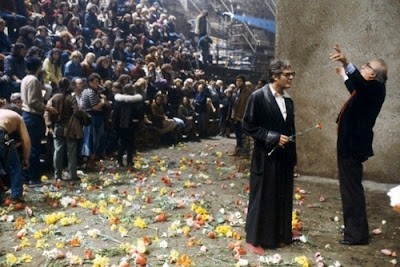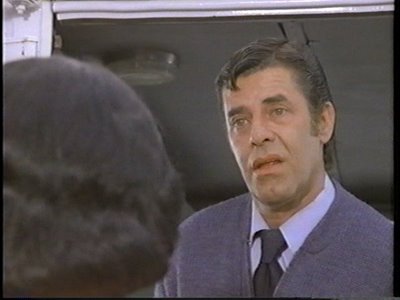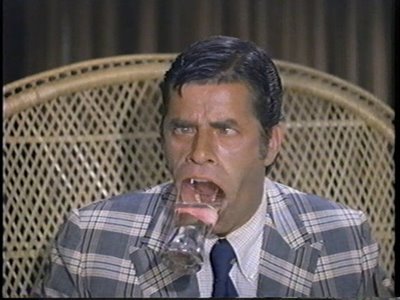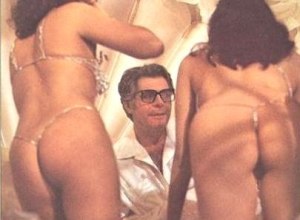From The Soho News (April 8, 1981). I haven’t reproduced all of this column, preferring to consign most of the latter part of it to oblivion. — J.R.
My dream scenario runs roughly like this: J. D. Salinger finally relents and allows Jerry Lewis to direct a film based on The Catcher in the Rye (“Salinger’s sister told me if anyone would get it from him it would be me,” Lewis remarked in a 1977 interview), and civilization as we know it collapses. In the ensuing sociocultural upheaval occasioned by this deconstruction of two critical reputations, anarchy reigns supreme: mad dogs roam the street, The New Yorker shrivels to a cinder out of acute, well-mannered embarrassment; and all those distinguished gray eminences in my profession who fear and loathe Lewis for what he says about their own bodies and social discomforts — some of whom shrink in terror from Tati for the same reasons — run screaming off to the Hamptons and Berkshires to write their own fiction, never to return.
As long as such a personal fulfillment fails to materialize, I guess you might say I’m hardly working. So is the cinema today, at least the kind I care about. Most serious European cinema is virtually banned in this country; major work in the 1970s by Akerman, Bresson, Duras, Godard, Rivette, Ruiz, Straub/Huillet, and Tati — which is allowed to occupy at least a small part of the intellectual life of Paris or London — scarcely exists even as hearsay on these shores. (After all, it might threaten the self-confidence of our taste-makers if they had to wrestle with anything more taxing than the shopping-mall goods of a Coppola or a Gaumont.) And it takes about a year from the time the latest Jerry Lewis movie (his first to be released in a decade) opens abroad to the time it straggles into trendy Manhattan, in a version twenty-odd minutes shorter. [2020 correction: Only six and a half minutes shorter, according to Chris Fujiwara’s definitive 2009 book on Lewis.] Even the excitement of a new Michael Snow film, PRESENTS , that I was able to see in Toronto last month, and will be appearing here shortly, has to be confined strictly to a ghetto. It’s clearly not challenging enough to most critics, who are still sweating over the intricacies of Paul Mazursky and Robert Benton. (Snow’s name isn’t even listed in the over seven thousand entries of Ephraim Katz’s 1979 The Film Encyclopedia.) Truffaut discovered this box office secret years ago: your degree of seriousness and complexity is often gauged by your capacity to deal exclusively with the middle class. HARDLY WORKING — which deals with the working class and unemployment, and speaks directly to the racially, culturally, and economically disenfranchised (to judge by the delighted audiences I’ve been seeing it with) — doesn’t rate on this scale at all.
***
A passionate Jerry Lewis fan since age seven (at MY FRIEND IRMA in 1950), I followed him religiously through his vehicles with Dean Martin in the 1950s. As I grew older, critics and friends started to teach me all the ways (and reasons why) I should dislike and be repelled by him; most of this had to do with either embarrassment or the unabashed artificiality of his public manner — an “education” that lasted through most of the 1960s. Then, for about the first half of the 1970s, I was lucky enough to be living in Paris — a freer, looser, and richer town than this one in certain respects — where I was able to resee a lot of Lewis’s best films (all of them directed by either Lewis or his mentor, Frank Tashlin) and read some of the very interesting local criticism about him. “Lewis is the only one making courageous films in Hollywood today,” Godard remarked in 1967. More recently, on Dick Cavett’s program last fall, Godard spoke wisely and well about the honesty of Lewis’s film and its title, and he is absolutely right. Barring only Godard’s own ICI ET AILLEURS and Wajda’s MAN OF MARBLE, HARDLY WORKING is the most politically honest film I’ve seen this year. As a key document of the Reagan era, it is the only one to date I can even begin to identify with. It is also unbearable, beautiful, terrible, wonderful, stupid, brilliant, awful, shocking, inept, and even very funny for various alternating stretches, much as Godard can be. The opening precredits montage, speeding us through a kind of refresher course in Lewis’s 1960s work, is really comparable only to the beginning of TOUT VA BIEN . On a conventional level, it “hardly works” at all.
As in THE BELLBOY (1960), Lewis’s first directed feature — also done in Florida locations on a minuscule budget — the gags follow a pattern of almost rigorous discontinuity: just one idea after another, each one stranger than the last. Thus the movie develops more on a thematic level (Lewis as a radically destructive force in the real world) than on a narrative one (an unemployed circus clown tries to hold a steady job). Directorially, it is perhaps his most mannerist film, particularly in its reaction shots, as mannerist as SEXTETTE or RED LINE 7000 or ERASERHEAD. Pictorially, it is as much about aging as the last westerns of Hawks. (Lewis’s face has never been half as interesting before.) Viscerally, it is as painfully direct about lost stamina as MAD WEDNESDAY or A KING IN NEW YORK, and not merely where Lewis is concerned: the sad, weary features of Harold J. Stone also compose a memorable site.
Like Salinger’s best work (“Raise High the Roof Beam, Carpenters,” not Catcher ), HARDLY WORKING is about being inordinately hated as well as disproportionately loved, by one’s self as well as by others — Lewis’s objective situation. “I’m really happy I met you, Bo,” the obligatory heroine (Deanna Lund) says to him; “You’re happy you met him ?” smirks her little boy—in the same tone of voice that a Fox publicist asked me, “You want to see this movie again?”
It’s logical enough that Lewis parodies SATURDAY NIGHT FEVER — for what is Travolta’s dancing in that movie but an autistic Lewis fantasy made socially acceptable? — but it’s Lewis’s peculiar form of honesty to show the fantasy deflated at once. “An inability to lie carried to the point of tragedy,” Raymond Bellour’s description of the last films of Fritz Lang, applies in spades here — even to some of the more grotesque details, such as Lewis wearing his expensive jewelry throughout, despite the fact that his character is either out of work or employed in menial jobs. When, toward the end of his stint as a postman, he arranges for a police escort to come along on his route, it’s obviously a police escort accompanying a celebrity through a Florida suburb. (Snow, Godard, and Lewis are a lot closer than is generally supposed: all three are interested in fields rather than plots and often use autobiography to furnish their conceptual constructs, e.g., the exhaustion of space as action in PRESENTS, LE GAI SAVOIR , and HARDLY WORKING.)
Whole sections of this film are plastered up to their eyeballs in product plugs, from Budweiser to Goodyear, and Lewis makes no effort whatsoever to hide this practice, recalling his candor about plugs in chapter 13 of his book The Total Filmmaker. The movie seems profoundly Jewish — in its relations to food (a wonderful, excruciating donut-sampling scene in Stone’s office) and to victimization, its Florida locations, its sexism, its playful sense of fantasy. Lewis’s character Bo collapses into Lewis himself in so many different ways that the total effect is that of a personal, materialist documentary — as someone once called Sternberg’s ANATAHAN , “My Heart Laid Bare.” (“They must need clowns,” Bo’s sister tells him consolingly after the circus closes. “Sure, honey,” Bo replies, “but who wants to get into politics?”)
In the final analysis, solipsistically and in terms of solipsism’s disastrous consequences, Jerry Lewis is America, and both are hardly working. So it’s hardly surprising that this is a movie that tells more truth than any of us is entirely ready to bear.
***
For years now, Fellini has been fast becoming a sort of limitless, structureless commodity, like salami or pepperoni, that can be sliced into at any point, yielding pretty much the same general consistency and flavor. The limits of a Fellini film thus often become the limit of his appetites and/or of mine, which seldom correspond precisely. I saw CITY OF WOMEN at a press show on March 5, over three weeks before I was asked to write about it; some vivid fragments still rattle in my memory, but much of the rest is dry-ice fog, as was no doubt the case on the 6th.
If CITY OF WOMEN seems to sprawl all over the place as limply as it does, this may partially be because, despite the legally demonstrable presence of Marcello Mastroianni in the central part, the film has no central character. It is like CASANOVA without Donald Sutherland, or 8 1/2 without Mastroianni, or JULIET OF THE SPIRITS with or without Giulietta Masina. Nor can it claim a subject, exactly. It has, perhaps, a little more to do with feminism than KAGEMUSHA has to do with chicken farming,but not so much that you couldn’t miss it if you blinked twice.

Anchorless and adrift, CITY OF WOMEN is a floating toy store that can easily be plundered by everyone to some extent; any customer can more or less count on walking away with a few indelible, irresponsible images, none of which has a particularly complex or interesting relation to any of the others. Take the best 15 minutes, combine them with the best 15 of ALTERED STATES, quadruple the results, and you might wind up with something that could blow most other current releases out of sight and mind. Unfortunately, the same hot air that pumps up these privileged moments of poetry and imagination can just as easily blow them away, too.








